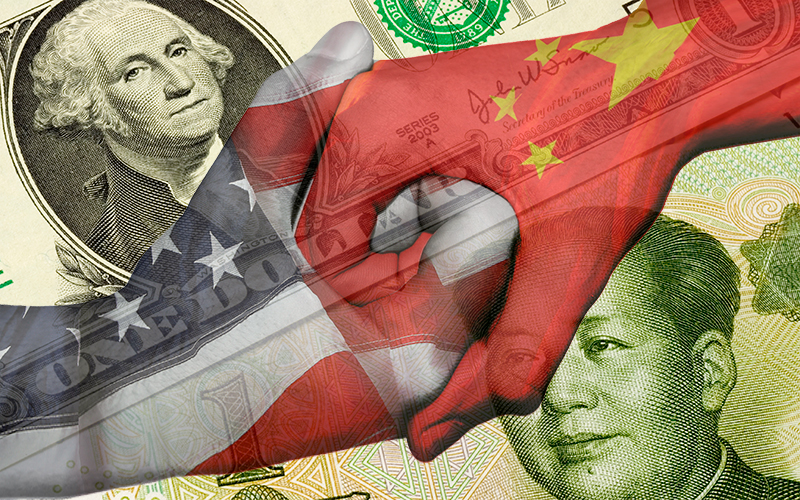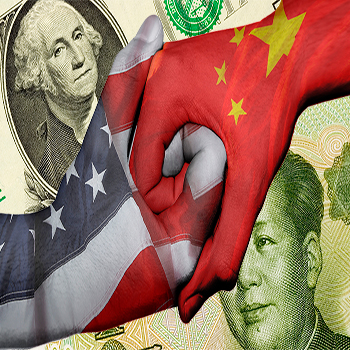U.S.-China Trade War May Hurt U.S. Companies Most

A number of analysts are warning that a trade war between the world's two largest economies could do more harm to U.S. companies than to Chinese companies.
As Donald Trump begins his first week as the 45th president of the United States, investors and policy makers are speculating about whether his implicit threats of a trade war with China during his campaign will materialize.
A number of analysts are warning that a trade war between the world's two largest economies could do more harm to U.S. companies than to Chinese ones, according to an analysis by Bloomberg.
Many more companies in the MSCI U.S. index for example, depend on China for at least 10 percent of their sales compared to Chinese companies that depend on the U.S. for the same amount of business, according to Morgan Stanley market strategist Jonathan Garner.
U.S. firms with the largest percentage of sales coming from China, and thus most likely to suffer from a trade war, are Ambarella Inc., Texas Instruments Inc., Marvell Technology Group, Genco Shipping & Trading Ltd., and Diana Shipping Inc., as indicated by the Bloomberg chart below.
Trumped-Up Trade Talk
In his inaugural address, Trump said the U.S. had allowed foreign industries to become enriched at the expense of American families and workers, who he promised to protect from “the ravages of other countries making our products, stealing our companies and destroying our jobs.”
Though Trump neither mentioned China specifically nor detailed any protectionist measures, it's very likely that China would retaliate to any steps taken by the U.S.
Bloomberg notes that China has already prepared contingency plans. A preview of the sweeping actions that China might take is illustrated by the boycotts it imposed on Japanese goods when tensions with Japan flared in 2012. (To read more, see: The Cost of Anti-Japanese Sentiment in China).
Trade War Fallout
While many are viewing the possibility of a trade war as more of a black swan event, the Chinese media had no trouble concluding from Trump’s inaugural speech that trade relations between the two countries were likely to change in dramatic ways.
Bloomberg warns that such dramatic changes could lead to Chinese boycotts of American products made by companies like Nike Inc., General Motors Co., Ford Motor Co. and Tiffany & Co.. (To read more, see: How Will Trump’s Policies on China Impact U.S. Business?).
Chinese producers, of course, also would be hit hard, especially in consumer electronics, apparel and household appliances. Yet, as noted, U.S. companies may be at more at risk in a U.S.-China trade war than the other way around. If that happens, watch for the stocks of companies most exposed to be sold off.
Source: Investopedia
Most Important Trading Partners of the United States
The United States as the biggest economy in the world has traditionally been at the center of global trade flows. China has taken the front seat as the most traded with partner. Most of the total worth of trade stems from imports. With Canada, the second most important trade partner, trade flows are more balanced.
This chart shows the top 5 U.S. trading partners for goods ($billions & % of total trade), year-to-date November 2016
Related China Trade White Papers
China Trade Operations: Trends and Advancements
While over 77% of companies are currently operating in China, the majority are unable to address the dynamic and complex trade environment - this Aberdeen Group report provides in-depth insights into the complexities of China trade operations. Download Now!
China and the World: New Frontiers, Fresh Connections
China's role in the global economy has gone from 11th largest to second, the country’s economy is now 60% that of the US, China’s relationship with the world is changing, this report sets out to examine these changes and what they mean for China and the rest of the world. Download Now!
The Keys to Effective China Trade Operations
China’s dominance as the world’s top country for sourcing hasn’t swayed under the pressures that have been the topic of discussion in the boardroom, on the campaign trail, around the dining room table, or during trade negotiations in nearly every country around the world. Download Now!
2016 Global Manufacturing Competitiveness Index
With the release of the 2016 Global Manufacturing Competitiveness Index (GMCI), Deloitte Touche Tohmatsu Limited (Deloitte Global) and the Council on Competitiveness (the Council) in the US build upon the GMCI research, with prior studies published in 2010 and 2013. Download Now!
U.S.-To-China B2c E-Commerce: Improving Logistics to Grow Trade
Merchants should carefully design their logistics strategy to promote the greatest efficiency and profits while addressing customers’ expectations and needs, based on factors such as their product mix, target geography, demographic segment, product price points, returns strategy, and more. Download Now!
Article Topics
Stanford Graduate School of Business News & Resources
Sustainable Procurement Barometer 2021 Apple CEO Praises Globalization in China Speech U.S.-To-China B2c E-Commerce: Improving Logistics to Grow Trade ‘Last Mile’ Solution for Driverless Trucks Technological Disruption and Innovation in Last-Mile Delivery U.S.-China Trade War May Hurt U.S. Companies Most From Click to Customer Delivery in 13 minutes, Amazon’s Prime Air Drone Trial Begins More Stanford Graduate School of BusinessLatest in Supply Chain
Walmart Unleashes Autonomous Lift Trucks at Four High-Tech DCs Ranking the Best Countries for Private Business in EMEA Frictionless Videocast: The Importance of Water at the U.S./Mexico Border with Commissioner Maria-Elena Giner, International Boundary and Water Commission Why are Diesel Prices Climbing Back Over $4 a Gallon? Plastic Pollution is a Problem Many Companies are Still Ignoring Luxury Car Brands in Limbo After Chinese Company Violates Labor Laws 80% of Companies Still Unsure How to Best Leverage AI, Study Finds More Supply Chain




















